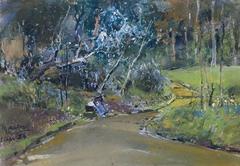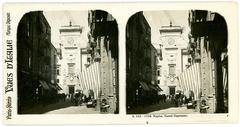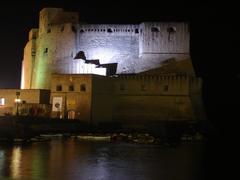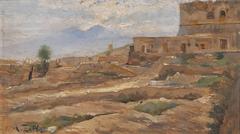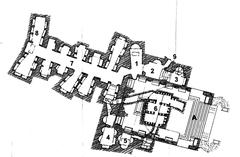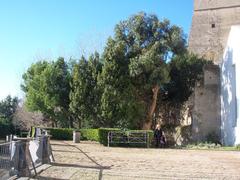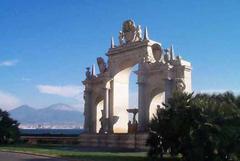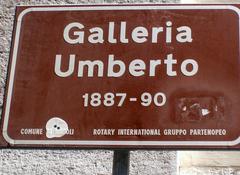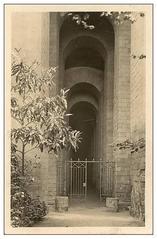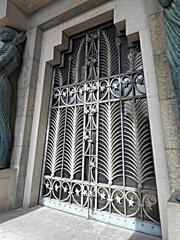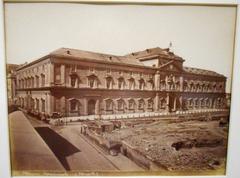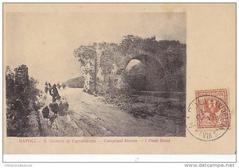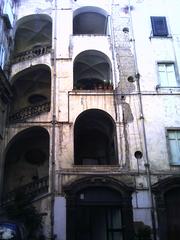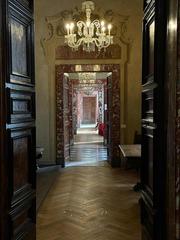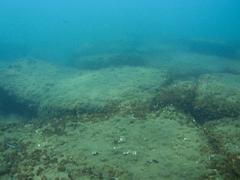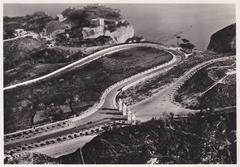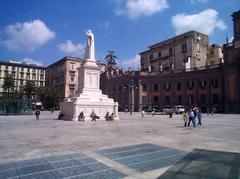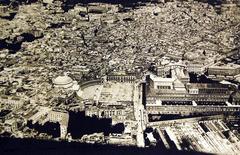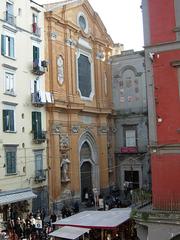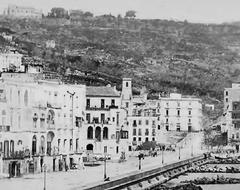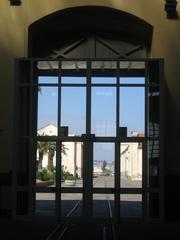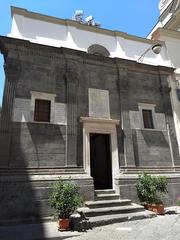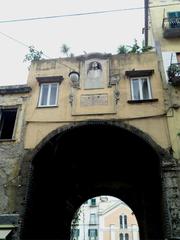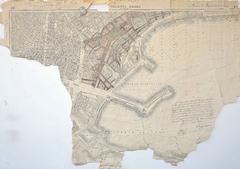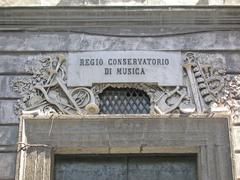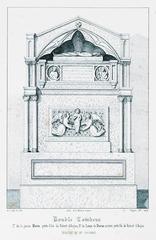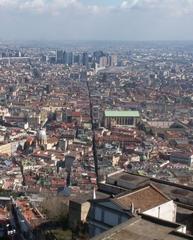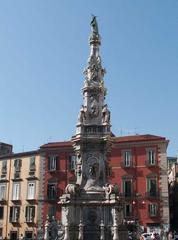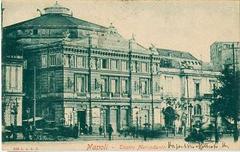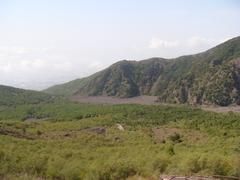Comprehensive Guide to Visiting Pedamentina a San Martino, Naples, Italy
Date: 19/07/2024
Introduction
Naples, Italy, is a city brimming with historical treasures and cultural landmarks, with the Pedamentina a San Martino standing as one of its most iconic sites. This historic stairway, dating back to the 14th century, was initially constructed to connect the Certosa di San Martino, a Carthusian monastery, with the bustling lower parts of the city. Over the centuries, the Pedamentina has played a significant role in the urban mobility and cultural fabric of Naples, serving as a vital route for transporting goods, a site for religious processions, and a beloved spot for local gatherings. Today, it remains a testament to the city’s rich history and architectural brilliance, attracting visitors from around the world eager to explore its 414 steps and panoramic views of Naples and the Bay of Naples (Naples Tourism, Architectural Digest). This comprehensive guide will delve into the origins, architectural significance, cultural impact, and practical aspects of visiting the Pedamentina a San Martino, ensuring a memorable and enriching experience for all.
Table of Contents
- Introduction
- Origins and Early Development
- Architectural Significance
- Role in Urban Mobility
- Cultural and Social Impact
- Modern-Day Relevance
- Visitor Information
- Travel Tips
- Restoration and Preservation Efforts
- Historical Events and Anecdotes
- Influence on Local Art and Literature
- Integration into Modern Urban Planning
- Visitor Experience and Accessibility
- FAQ Section
- Conclusion
Origins and Early Development
The Pedamentina a San Martino is a historic stairway in Naples, Italy, that dates back to the 14th century. It was constructed as a means to connect the Certosa di San Martino, a Carthusian monastery, with the lower parts of the city. The stairway was initially built to facilitate the movement of monks and goods between the monastery and the bustling city below. The construction of the Pedamentina was part of a broader urban development plan initiated by Charles of Anjou, who sought to enhance the city’s infrastructure (Naples Tourism).
Architectural Significance
The Pedamentina a San Martino is renowned for its architectural ingenuity. The stairway comprises 414 steps, winding through a series of terraces that offer panoramic views of Naples and the Bay of Naples. The design of the stairway reflects the medieval architectural style, characterized by its functional yet aesthetically pleasing structure. The use of local volcanic tuff stone in its construction not only provided durability but also integrated the stairway seamlessly into the natural landscape (Architectural Digest).
Role in Urban Mobility
During the Renaissance period, the Pedamentina a San Martino played a crucial role in urban mobility. It served as a primary route for transporting goods, particularly agricultural produce, from the rural areas surrounding the Certosa di San Martino to the markets in the city. The stairway’s strategic location and design made it an efficient and reliable means of transportation, significantly contributing to the economic vitality of Naples during this period (Historical Naples).
Cultural and Social Impact
The Pedamentina a San Martino has also been a significant cultural and social landmark in Naples. Over the centuries, it has been a site of religious processions, local festivals, and community gatherings. The stairway’s terraces have served as vantage points for observing various cultural events, including the famous Neapolitan nativity scenes during Christmas. The Pedamentina has thus been an integral part of the social fabric of Naples, fostering a sense of community and shared heritage among its residents (Cultural Naples).
Modern-Day Relevance
In contemporary times, the Pedamentina a San Martino continues to be a vital part of Naples’ urban landscape. It has become a popular tourist attraction, drawing visitors from around the world who are eager to explore its historical and architectural significance. The stairway is also a favorite spot for local residents, who use it for daily walks and exercise, enjoying the scenic views and tranquil environment it offers. Efforts have been made to preserve and maintain the Pedamentina, ensuring that it remains a cherished landmark for future generations (Tourism Naples).
Visitor Information
For those planning a visit, here are some essential details:
- Visiting Hours: The Pedamentina a San Martino is open year-round, but it is best visited during daylight hours to fully appreciate the views and safely navigate the steps.
- Tickets: There is no admission fee to access the stairway. It is a public pathway open to all.
- Accessibility: While the stairway is accessible to the public, it may pose challenges for those with mobility issues due to the number of steps and uneven surfaces. Handrails and resting areas are available along the route.
Travel Tips
- Best Times to Visit: Early morning or late afternoon are ideal times to visit to avoid the midday heat and enjoy the best lighting for photographs.
- Nearby Attractions: The Certosa di San Martino and Castel Sant’Elmo are nearby historical sites worth exploring. The Vomero district also offers a variety of shops, cafes, and restaurants.
- Guided Tours: Consider joining a guided tour to gain deeper insights into the historical and cultural significance of the Pedamentina a San Martino.
- Photography Spots: The terraces along the stairway provide excellent vantage points for capturing panoramic views of Naples and the Bay of Naples.
Restoration and Preservation Efforts
The preservation of the Pedamentina a San Martino has been a priority for local authorities and heritage organizations. Restoration projects have been undertaken to repair and stabilize the stairway, addressing issues such as erosion and structural damage caused by centuries of use and exposure to the elements. These efforts have been supported by both public and private funding, reflecting the importance of the Pedamentina as a cultural and historical asset. The restoration work has also included the installation of informative plaques and signage, providing visitors with insights into the stairway’s history and significance (Heritage Naples).
Historical Events and Anecdotes
The Pedamentina a San Martino has been witness to numerous historical events and anecdotes. During the Napoleonic Wars, the stairway was used by French troops to access strategic points in the city. In the 19th century, it became a popular subject for artists and writers, who were captivated by its picturesque setting and historical ambiance. The stairway has also been featured in various literary works and films, further cementing its status as an iconic symbol of Naples (Naples History).
Influence on Local Art and Literature
The Pedamentina a San Martino has had a profound influence on local art and literature. Its scenic beauty and historical significance have inspired countless artists, poets, and writers. The stairway has been depicted in numerous paintings, photographs, and literary works, capturing its essence and charm. Notable Neapolitan artists such as Giacinto Gigante and Domenico Morelli have created masterpieces that feature the Pedamentina, showcasing its role as a muse for creative expression (Art Naples).
Integration into Modern Urban Planning
The integration of the Pedamentina a San Martino into modern urban planning has been a testament to its enduring relevance. Urban planners have recognized the stairway’s potential as a sustainable and eco-friendly mode of transportation, promoting its use as an alternative to vehicular traffic. The stairway’s preservation has also been incorporated into broader urban development projects, ensuring that it remains a vital part of Naples’ cultural and historical landscape (Urban Planning Naples).
Visitor Experience and Accessibility
For visitors, the Pedamentina a San Martino offers a unique and immersive experience. The stairway provides a journey through history, allowing visitors to explore its architectural features and enjoy breathtaking views of the city. Efforts have been made to enhance accessibility, with the installation of handrails and resting areas along the route. Guided tours and informational materials are available, providing visitors with a deeper understanding of the stairway’s history and significance (Visit Naples).
FAQ Section
What are the opening hours of the Pedamentina a San Martino? The stairway is open year-round, but it is best visited during daylight hours.
Is there an admission fee to visit the Pedamentina a San Martino? No, the stairway is a public pathway and free to access.
Are there any guided tours available? Yes, guided tours are available and recommended to gain deeper insights into the historical and cultural significance of the site.
What nearby attractions can I visit? Nearby attractions include the Certosa di San Martino, Castel Sant’Elmo, and the Vomero district.
Conclusion
The Pedamentina a San Martino stands as a remarkable testament to Naples’ rich history and cultural heritage. Its architectural brilliance, historical significance, and enduring relevance make it a must-visit destination for anyone exploring the city. Through ongoing preservation efforts and thoughtful integration into modern urban planning, the Pedamentina continues to be a cherished landmark, offering a glimpse into the past while remaining an integral part of Naples’ vibrant present. For more travel tips and insights into Naples’ historical sites, follow us on social media and download our mobile app Audiala (Naples History, Urban Planning Naples, Visit Naples).
References
- Comprehensive Guide to Visiting Pedamentina a San Martino, 2024, Naples Tourism
- Exploring Pedamentina a San Martino - Visiting Hours, Tickets, and Historical Significance in Naples, 2024, Historical Naples
- Complete Guide to Visiting Pedamentina a San Martino in Naples, 2024, Naples Transport
